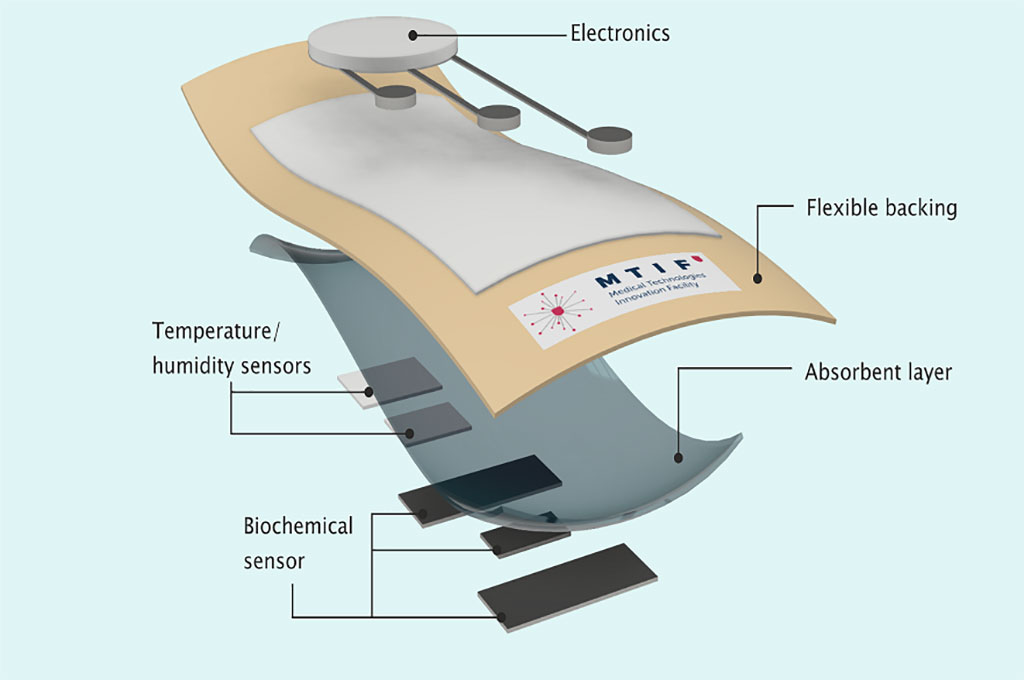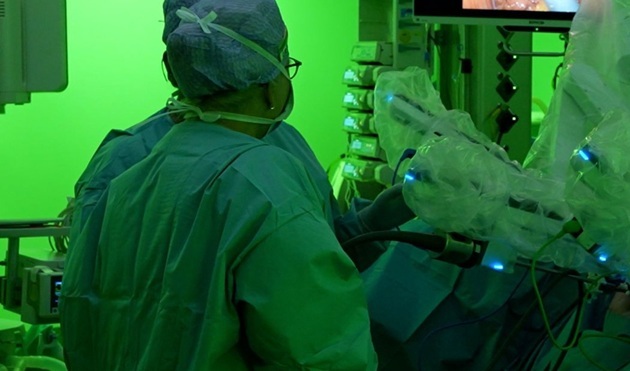Miniature Biosensor Accurately Monitors Condition of Chronic Wounds
|
By HospiMedica International staff writers Posted on 05 Sep 2022 |

Wounds represent a burgeoning health care issue affecting thousands of patients in all health and social care settings, leading to a spiraling expenditure on an already overloaded health system. One of the most urgent needs in wound management is the development of systems that allow clinicians to identify the early progression or deterioration of wounds. Patients can not currently assess the condition of a wound and health professionals are required to remove the dressing to assess it visually. This can take time as patients require an appointment and removing the dressing too soon risks lengthening the healing process, making scarring worse, or introducing an infection. The dressing also needs replacing each time the wound is checked, which takes more time. Chronic wounds include wounds as a result of serious injury or trauma, ulcers, pressure sores or through diseases such as diabetes. Now, a newly-developed biosensor is capable of accurately monitoring the condition of a chronic wound.
The biosensor has been developed by a team of engineers and clinical academics at Nottingham Trent University (NTU, Nottingham, UK) who are aiming for the technology to be embedded into dressings so that they do not need to be continually removed and replaced to assess how a wound is healing. The team believes that that in time, the technology – a textile-based printed protein sensor – could help to reduce the risk of patients becoming seriously ill, prevent amputation, and save time and money.
The new sensor, which is printed onto fabric would be integrated in the dressing, uses electrodes to analyze the concentration of specific proteins in a wound constantly and in real time. Using app-based technology, the patient would be able to take a reading and receive some simple information by holding a smartphone near to the dressing. They would then be able to book an appointment, if necessary, so that it can be checked by a clinician. The miniature sensor, which is lightweight and flexible, would be able to determine whether the dressing required changing, can come off completely or if the wound has an infection. The researchers believe that now the technology is established, the next step will be to work with consultant clinicians and digital technology providers to look at moving it into commercial products.
“There is currently no way to monitor the condition of a wound without booking an appointment, having the dressing removed and taking a look,” said researcher Dr Yang Wei, an expert in electronic textiles and electronic engineering in Nottingham Trent University’s School of Science and Technology. “The sensor analyses chemical biomarkers to give an indication of whether a wound is healing or not and could help remove a range of risks associated with continuous and laborious removal and replacement of dressings. As well as improving patients’ quality of life, it could speed up the healing process, help to avoid infection and avoid worsening scars by removing dressings while they are still forming.”
Related Links:
Nottingham Trent University
Latest Critical Care News
- Soft Robots Could Donate Their Heart to Humans
- Bioadhesive Strategy Prevents Fibrosis Around Device Implants on Peripheral Nerves
- Miniature Non-Invasive Robotic Catheters to Improve Infertility Treatments
- Stick-On Patch Monitors Baby's Movements In Utero
- EEG-Based AI Technology Accurately Diagnoses Alzheimer’s and Dementia
- Robot Lymphatic System Paves Way for Self-Powered Wearables and Machines
- Focused Ultrasound Technique Successfully Treats Pediatric Brain Cancer
- Nasal Drops Fight Brain Tumors Noninvasively
- AI Helps Optimize Therapy Selection and Dosing for Septic Shock
- Glowing Bacteria ‘Pills’ for Detecting Gut Diseases Could Eliminate Colonoscopies
- Skin-Permeable Polymer Patch Delivers Insulin Non-Invasively Through Skin
- Nanogel Technology Almost 100% Effective in Destroying Drug-Resistant Bacteria Within Hours
- Wearable Ultrasound Sensor Delivers Noninvasive Treatment Without Surgery
- Gel-Free ECG System to Transform Heart Health Diagnosis
- Biodegradable Patch Repairs Damaged Tissue After Heart Attack
- Magnetically Guided Microrobots to Enable Targeted Drug Delivery

Channels
Surgical Techniques
view channel
Minimally Invasive Surgery Proven Safe and Effective for Complex ‘Whipple’ Procedure
Tumors of the pancreatic head often require a highly complex operation known as pancreatoduodenectomy or the Whipple procedure. This surgery involves removing multiple structures and creating several internal... Read more
Catheter-Based Procedures Offer Less Invasive Option for Treatment of Valvular Disease
Valvular heart disease, caused by tight or leaky valves between heart chambers, affects up to 10% of older adults and leads to more than 120,000 deaths globally each year. Traditional open-heart surgery... Read morePatient Care
view channel
Revolutionary Automatic IV-Line Flushing Device to Enhance Infusion Care
More than 80% of in-hospital patients receive intravenous (IV) therapy. Every dose of IV medicine delivered in a small volume (<250 mL) infusion bag should be followed by subsequent flushing to ensure... Read more
VR Training Tool Combats Contamination of Portable Medical Equipment
Healthcare-associated infections (HAIs) impact one in every 31 patients, cause nearly 100,000 deaths each year, and cost USD 28.4 billion in direct medical expenses. Notably, up to 75% of these infections... Read more
Portable Biosensor Platform to Reduce Hospital-Acquired Infections
Approximately 4 million patients in the European Union acquire healthcare-associated infections (HAIs) or nosocomial infections each year, with around 37,000 deaths directly resulting from these infections,... Read moreFirst-Of-Its-Kind Portable Germicidal Light Technology Disinfects High-Touch Clinical Surfaces in Seconds
Reducing healthcare-acquired infections (HAIs) remains a pressing issue within global healthcare systems. In the United States alone, 1.7 million patients contract HAIs annually, leading to approximately... Read moreHealth IT
view channel
EMR-Based Tool Predicts Graft Failure After Kidney Transplant
Kidney transplantation offers patients with end-stage kidney disease longer survival and better quality of life than dialysis, yet graft failure remains a major challenge. Although a successful transplant... Read more
Printable Molecule-Selective Nanoparticles Enable Mass Production of Wearable Biosensors
The future of medicine is likely to focus on the personalization of healthcare—understanding exactly what an individual requires and delivering the appropriate combination of nutrients, metabolites, and... Read moreBusiness
view channel
Philips and Masimo Partner to Advance Patient Monitoring Measurement Technologies
Royal Philips (Amsterdam, Netherlands) and Masimo (Irvine, California, USA) have renewed their multi-year strategic collaboration, combining Philips’ expertise in patient monitoring with Masimo’s noninvasive... Read more
B. Braun Acquires Digital Microsurgery Company True Digital Surgery
The high-end microsurgery market in neurosurgery, spine, and ENT is undergoing a significant transformation. Traditional analog microscopes are giving way to digital exoscopes, which provide improved visualization,... Read more
CMEF 2025 to Promote Holistic and High-Quality Development of Medical and Health Industry
The 92nd China International Medical Equipment Fair (CMEF 2025) Autumn Exhibition is scheduled to be held from September 26 to 29 at the China Import and Export Fair Complex (Canton Fair Complex) in Guangzhou.... Read more












